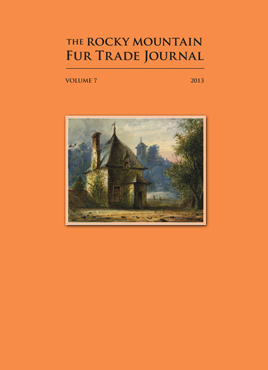$19.95
2013 Rocky Mountain Fur Trade Journal, Volume 7
An annual academic peer-reviewed publication intended to further the knowledge and discussion of the Rocky Mountain fur trade era and provide an avenue for researchers to showcase their work.
Full color, perfect bound, 8″ x 11″, softback, 124 pages
ISSN: 1937-0733
Journal is provided FREE with a purchase of an annual membership!!! Click here to purchase a membership now!
Description
2013 Rocky Mountain Fur Trade Journal, Volume 7
Arikara Niitunisu Beliefs and the Fur Trade
by Dr. Mark van de Logt
The article shows foreign traders gradually losing their status as supernatural spirits and becoming something more darkly human in the eyes of the Arikara. The perception of the Arikara were that of the Euro-Americans bringing recurring epidemics that devastated the tribes.
Fact and Fancy in Alfred Jacob Miller’s Early Watercolors, 1837-39
by Dr. Lisa Strong
Many readers are familiar with the artwork of Alfred Jacob Miller the only artist who attended a Rocky Mountain rendezvous. Many historians use Miller’s images as historical evidence of fur trade material culture. The article shows the insightful comparisons of various phases of the artist’s career and illuminations of the pitfalls of assuming that Miller’s artwork can be considered historical data.
Where was Fort William?
by Scott Walker
An examination of Miller’s paintings of Fort William (later known as Fort Laramie) for evidence of that structure’s historical location. Though the original site is yet to be determined by archaeologists, Scott Walker shows that careful attention to detail – in both the artwork and Miller’s commentary – can yield interesting results.
Commerce in the Rocky Mountain Fur Trade: Two 1830 Promissory Notes
by Clay J. Landry
An explanation of the financial system of the fur trade and the significance of these drafts for the two illiterate men who held them.
Bartolome Baca and the Opening of the Mexican Southwest
by J. Ryan Badger
Baca, governor of the province of Santa Fe de Nuevo Mexico from 1823-25, helped initiate commerce by sidestepping Mexican statutes to encourage beaver trapping. J. Ryan Badger demonstrates how Baca’s independent streak affected the American fur trade.
Trappers’ Brides: Intercultural Marriages in the Rocky Mountain Fur Trade
by Dr. Kathleen Barlow
Parsing the fantasy and the reality in Miller’s artwork to separate Euro-American assumptions about Native American women from the actual roles those women fulfilled in their societies. Ultimately Dr. Kathleen Barlow offers a way to reframe Miller’s images and writing to better appreciate Indian women’s place in the Rocky Mountain fur trade.
Murthly: Castle of the Rocky Mountain Fur Trade
by James C. Auld
A glimpse into the personal life of Sir William Drummond Stewart that is anchored in the history of his ancestral home, Murthly Castle.
Stewart came to the Rockies in 1833 and spent nearly a decade attending rendezvous, adventuring with fur trappers, and collecting artifacts. When he returned to Scotland, he renovated his ancestral home as a memento of his American experiences.
Sublette County Historical Society, 2013
Additional information
| Weight | 16 oz |
|---|---|
| Dimensions | 11 × 8 × 1.25 in |

